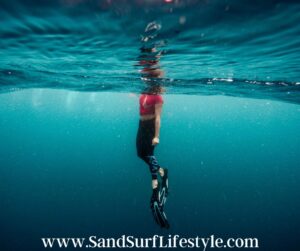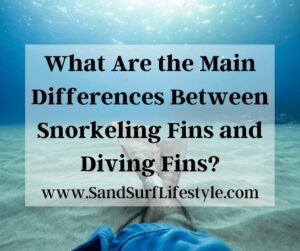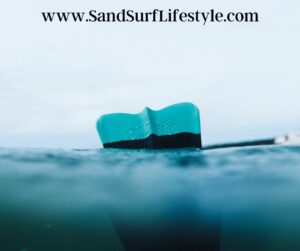What Are the Main Differences Between Snorkeling Fins and Diving Fins?
Snorkeling and SCUBA diving are both fun and exciting ways to spend a day in the water, while also getting the chance to interact with many different forms of marine life in their natural environment. While there are several differences between diving and snorkeling, one of the most significant differences lies in the type of equipment used for both. This is perhaps the most apparent when it comes to snorkeling fins and diving fins. So, what are the differences between snorkeling fins and diving fins?

There are four key differences between snorkeling fins and diving fins. These differences include:
● Diving fins are longer than snorkeling fins.
● The thrust efficiency is better with diving fins.
● The blades are stiffer on diving fins than on snorkeling fins.
● Diving fins are usually open-heeled.
In this article, we are going to take a closer look at the four major differences between diving fins and snorkeling fins. We will also closely examine the difference these fans can make in the thrust you can generate from your kicking power, as well as how the different designs affect the equipment required for snorkeling and diving. I will also include recommendations for the best diving and snorkeling fins available for you to purchase.
Diving Fins Are Longer Than Snorkeling Fins
Perhaps the most obvious difference between snorkeling fins and diving fins is their length. The average length of snorkeling fins measures between 20 and 25 inches long, while the average length of diving fins is between 25 and 30 inches long. This is because longer fins are capable of generating more thrust than shorter ones, and SCUBA diving requires you to maximize thrust efficiency if you want to be able to dive deeper below the ocean’s surface.
When you are diving, you are going to have much more equipment on and than you will have when you are snorkel. With the added weight of all of this extra equipment, you are going to certainly appreciate the longer Blades of diving fins. They allow you to maneuver throughout the water while exerting less effort than you would by using snorkeling fins. After a long day of diving, your legs will thank you for this.
The Thrust Efficiency Is Better With Diving Fins
According to Tidetrek, thrust is defined as “the force that propels you forward in response to the backward force of your kicks.” With that said, The more power you can generate with your kicks, the more thrust you will be able to create. This can mean a world of difference in your ability to generate power and speed while you are diving. Because they weigh significantly more than snorkeling fins, diving fins require more power to generate the thrust that you need.
If there is a downside to diving fins, it is that learning to move with Precision underwater can be a difficult task to master. However, there are a variety of different techniques that you can learn that will help you to maneuver around the water like a pro. For example, learning to master the frog kick will help you move more efficiently when you are closer to the seafloor. The helicopter kick will allow you to turn in place, while the reverse kick allows you to move backward. These are all techniques you will learn to master with diving fins.
 The Blades Are Stiffer on Diving Fins Than on Snorkeling Fins
The Blades Are Stiffer on Diving Fins Than on Snorkeling Fins
Because of the depth of water in which divers operate, as well as the extra gear required for diving, the blades of SCUBA fins are far stiffer than their snorkeling counterparts. Snorkeling fins are made from material that is much more flexible than diving fins. This is because most of the activity that takes place during snorkeling happens just under the water’s surface. The deeper you dive, the greater the water pressure will be. You need a stiffer blade to navigate through this increased water pressure.
Because snorkeling fins are shorter than diving fins, you might believe that they would be more rigid. However, this is not the case. Diving fins are usually made from plastic or polypropylene, which tends to be much stiffer than the softer rubber material from which snorkeling fins are made. This is because diving fins must be less flexible than snorkeling fins due to the water pressure and depths through which you are navigating.
Diving Fins Are Usually Open-Heeled
Once again, the additional equipment required for diving plays a key role in the difference between snorkeling fins and diving fins. The majority of diving fins will usually have an open heel, which is specifically designed to compensate for dive boots. The open heel design of diving fins makes it much easier to put them on or to remove them. The neoprene that diving fins are made from is also able to adjust more easily to the changing water pressure that you will encounter while diving.
Because snorkeling fins are meant to be worn with your bare feet, they are made of a much softer material than diving fins. They also have a much simpler design than diving fins, which have channels along with the blades that help to propel water. Although it may initially seem hard to believe, full-footed fins also weigh much less than open-heeled fins. This is mainly due to the sturdier material that diving fins are made from, as well as the excess length of the blades.
Do you know what the pros and cons of Nitrox diving are? Learn more here.
What Are the Top Recommended Diving Fins?
 When you are driving, there are different types of fins that you can purchase for different purposes. While some diving fins may be perfect for travel, others may be best for diving in cold water. Some things are perfect for entry-level divers, while others are perfect for seasoned veterans. According to Nature Tripper, here are the best bins for each category of diving:
When you are driving, there are different types of fins that you can purchase for different purposes. While some diving fins may be perfect for travel, others may be best for diving in cold water. Some things are perfect for entry-level divers, while others are perfect for seasoned veterans. According to Nature Tripper, here are the best bins for each category of diving:
● Best all-around fins – Mares Avanti Quattro Plus Dive Fins
● Best fins for travel – Tusa Highflex Switch Dive Fins
● Best fins for cold water diving – Apex RK3 Military Dive Fins
● Best entry-level fins – Oceanic Viper Dive Fins
● Best split fins – Atomic Aquatics Dive Split Fins
What Are the Top Recommended Snorkeling Fins?
 Contrary to popular belief, it is not recommended that you use snorkeling fins when diving, and vice versa. Diving fins and snorkeling fins have specific designs that are made to function perfectly in their respective environment. Just like with diving fins, different types of snorkeling fins fit all kinds of different lifestyles. The best snorkeling fins in each category are:
Contrary to popular belief, it is not recommended that you use snorkeling fins when diving, and vice versa. Diving fins and snorkeling fins have specific designs that are made to function perfectly in their respective environment. Just like with diving fins, different types of snorkeling fins fit all kinds of different lifestyles. The best snorkeling fins in each category are:
● Mares Superchannel Snorkel Fins – Best all-around fins
● Aqua Lung Express Snorkel Fins – Best high-end Speed fins
● Scubapro GO Travel Snorkel Fins – Best travel fins
● Mares Quattro Power Snorkel Fins – Best advanced fins
● Sier Snorkel Split Fins – Beast easy-kick fins
Conclusion
Diving requires you to be able to generate much more thrust, while also being more efficient with your leg kicks than when snorkeling. For this reason, diving fins AR are significantly longer than snorkeling fins and are also known for being able to generate more thrust while not having to exert much more effort. The increased water pressure experienced by wild diving is a key factor in designing diving fins with stiffer blades and snorkeling fins as well.
Finally, the rigid design of diving fins can be attributed to the extra equipment that divers must wear. This is also the primary reason for diving fins having an open-heel design. When you are navigating me murky depths of the ocean, the type of fins you choose can be the difference between a successful dive and an unsuccessful one. Why leave this to chance? Now that you know the difference between diving fins and snorkeling fins, you can make the choice that’s right for you and your hobby of choice.
Related Questions
What are the best SCUBA diving destinations in the United States? There are lots of great places to dive around the United States. Fortunately, most of these diving destinations are located along the Pacific and Atlantic coastlines. According to SCUBA Diver Life, the following areas are the five best spots in the United States to dive:
● Monterey Bay, California
● Santa Catalina Island, California
● Channel Islands, California
● Southeast Florida
● Florida Keys
How can I improve on how long I can hold my breath while snorkeling? If you are facing directly down into the water, with your snorkel above the waterline, there is no limit to the amount of time that you can snorkel. However, the average human being can only hold their breath anywhere between 45 seconds and one minute. Improving your physical condition is the best way to improve the amount of time that you can hold your breath underwater. However, there are other breathing techniques that you can use that will also help. To increase your lung capacity, hold your breath for 1 minute, and then exhale for one minute. Try to increase the exhale Time by five-second intervals each time as you repeat.

Please note: This blog post is for educational purposes only and does not constitute legal or medical advice. Please consult a legal expert or medical professional to address your specific needs.


 The Blades Are Stiffer on Diving Fins Than on Snorkeling Fins
The Blades Are Stiffer on Diving Fins Than on Snorkeling Fins